This Japanese milk bread is the softest, lightest & fluffiest bread ever, it reminds me of my favorite artisan bread. Easily convert your regular bread recipe & you will never look back. I guarantee.
Couple years back, I attempted to make my first ever bread. My friend had a bread machine sitting around in her garage so she was more than happy to have it put to use. Apparently, I wanted to go gluten free because that would have explained why I had chosen spelt bread as my first choice of bread to bake. That, or I was stupidly ignorant.
I ended up with a brick bread.
A brick spelt bread, that is.
I promptly relieved the bread machine of its torture from me whacking it with my brick bread. That was my first and last time baking bread… until I got a Vitamix last year. It seems that one can “knead” bread dough in a Vitamix and rise time was only 20 minutes. I was sold!
This happiness was short lived.
I ended up with a dense, gummy whole wheat bread. The Vitamix wasn’t even kneading per se. It was just bringing together the dough. I could do that with my a wooden spoon and a bowl. Geez. I love my Vitamix but definitely not in the kneading bread dough department.
Next up, good old regular hand kneading and recently employing a stand mixer. Regardless of the different methods employed, I just simply couldn’t get the bread texture to where I wanted it to be. It really felt like the bread Gods were against me.
Then, a couple weeks ago, I was walking around Little Tokyo. Two things happened there.
One, I saw Rainn Wilson. Crazy coincidence.
Two, I almost lay my head on one of the most pillowy soft bread I’ve ever seen. It was a Hokkaido Milk Bread or Japanese Milk Bread.
The bread reminded me of a super soft bread in Malaysia sold on a motorcycle by a “breadman” (or roti man, roti meaning bread in Malay) that I regularly consume when I was young.
It was love at first sight.
Hokkaido Milk Bread employs the tangzhong method where a pudding like roux (made up of flour and liquid) is first cooked and then added to the rest of the ingredients for the dough. When the roux is heated to at least 149 F, it helps leaven the bread. It also locks in the moisture thereby adding lift, fluff and softness to it.
Milk bread is also rolled in a certain way (unlike traditional shaping) so that when baked, it helps heighten the bread which equals more fluffiness. Butter is added later to allow the gluten to form a strong network (fat makes things slippery).
Once baked, it results in a beautiful golden brown bread that’s uber soft with added richness from the milk and extra flavor from the butter and the egg. Best part is, this bread stays soft for a couple of days unlike most bread that turns to brick fairly quickly.
Mr. V rarely says anything nice when he eats what I make. Not even a bowl of Taiwanese Beef Noodles would bring words out of his mouth. But then, out of nowhere, I got a “Hmmm, this is delicious…” when he had PB&J with this bread. I almost had a heart attack. So amazing what this bread can do.
Tip: You can easily convert any of your current bread recipes to apply the tangzhong method in order to enjoy extra soft and fluffy bread. All that’s required is a couple of math equations and a short brain freeze. You’ll be good to go.
Here’s how. Let’s say your bread recipe requires 12.75 oz flour and 8.5 oz liquid (a 67% hydration).
1. Quantity of flour and liquid for the tangzhong:
Flour: 5-12% of the total weight of flour in any bread recipe is needed for the tangzhong. The higher the percentage, the stickier the dough will become, the longer you’ll have to knead. For this recipe, I only use 5%.
Liquid: Multiply the weight of flour by five to get the amount for liquid.
If applying 5%, you’ll need 0.65 oz flour (5% of 12.75 oz) for the tangzhong. As for liquid, you’ll need 3.25 oz (0.65 X 5).
If applying 10%, you’ll need 1.25 oz flour and 6.25 oz liquid for the tangzhong.
2. Quantity of flour and liquid for the dough:
Flour: You’ve used 0.65 oz flour for the tangzhong so what’s left is 12.1 oz (12.75 oz – 0.65 oz) flour for the dough.
Liquid: You’ve used 3.25 oz liquid for the tangzhong so what’s left is 5.25 oz (8.5 oz – 3.25 oz) liquid for the dough.
3. Liquid used: Milk or a combination of milk, heavy cream or half and half.
4. Other ingredients (like yeast, sugar and salt) remain the same in your original recipe.
If you like what you see, don’t forget to subscribe or follow me on Instagram, Facebook, Pinterest or Twitter to get the latest post updates. See you there!
- Tangzhong
- 3.25 oz milk
- 0.65 oz bread flour
- Dough
- 5.25 oz milk (or a combination of milk, heavy cream or half and half)
- 2 tbs sugar (or more depends on how sweet you like your bread)
- 2¼ tsp (1 pack) active dry yeast
- 12.1 oz bread flour
- 1 tsp salt
- 1 room temperature egg
- 1 tbs unsalted butter, softened
- Egg wash
- 1 egg, lightly beaten
- Some milk
- Activate Yeast : In a small bowl, add the warm milk, sugar and yeast. Give it a stir and let sit for 10 minutes.
- Tangzhong: In a small pan, over medium low heat, combine the milk and flour for the tangzhong. Whisk until thick like pudding. It takes a couple of minutes. It's ready when line streaks stay visible on the roux (or the temperature is 149 F). Set aside and let cool.
- Make Dough: In a stand mixer bowl, whisk the flour and salt together. Crack the egg in, add the yeast mixture and the tangzhong. Stir with a wooden spoon until it roughly comes together.
- Knead: Using a stand mixer, knead on low speed for 5 minutes. Add the butter and knead for another 5-7 minutes. Dough may stick to the bottom of the bowl. Scrape and give it a fold so that the dough is evenly kneaded. To know if dough is ready, dust some flour on the sticky dough and poke it. If it springs back immediately, it's ready.
- First Rise: Allow the dough to rise (covered) in a warm, draft free place for 1 - 1½ hours or until double in size.
- Shape: Divide the dough into 3 equal parts and shape each into a ball. Using a rolling pin, roll out the dough until it becomes a long oval. Fold one side (lengthwise) into the middle and then fold in the other side as well. Use the rolling pin and flatten it. Now, roll the dough into a cylinder. Pinch the seams. Place it seam side down into a greased 8" X 4" loaf pan. Repeat with the remaining two dough.
- Second Rise: Cover and let rise again for 1 - 1½ hours or until double in size (or top of dough has risen over the top of the pan by 1" - ½". 30 minutes before the loaf is ready, preheat the oven to 350 F.
- Bake and cool: When the bread is ready to bake, brush the top of the bread with egg wash and bake for 30 minutes. Loosely tent the bread with aluminum foil if it's browning too much during the last 5 minutes of baking. Remove the bread from the pan immediately and let it cool on a wire rack.
If you’re into soft pillowy things like this bread, then you’re going to love this No Knead Garlic Cheese Naan. Great flavors from the garlic & butter, beautifully charred & crisp outside yet insanely soft, chewy with melting cheese inside. By the way, if you are not really into baking, Butter + Cream Bakery is a Custom Bakery that offers a great selection of bakeries, be sure to check them out!

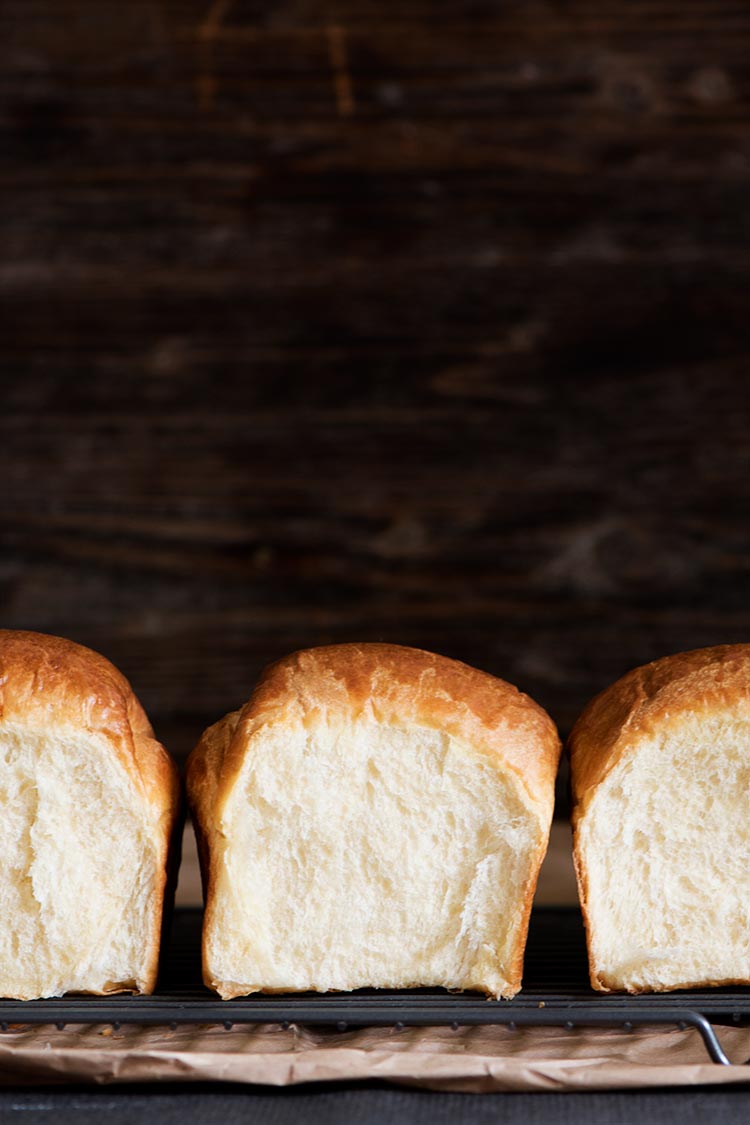
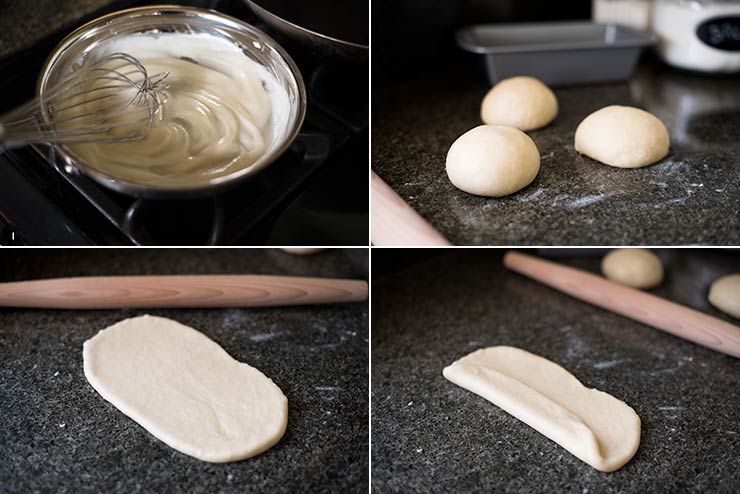
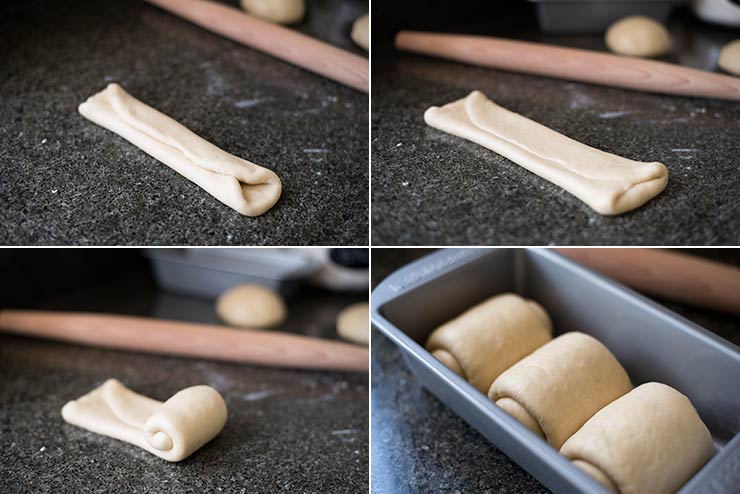
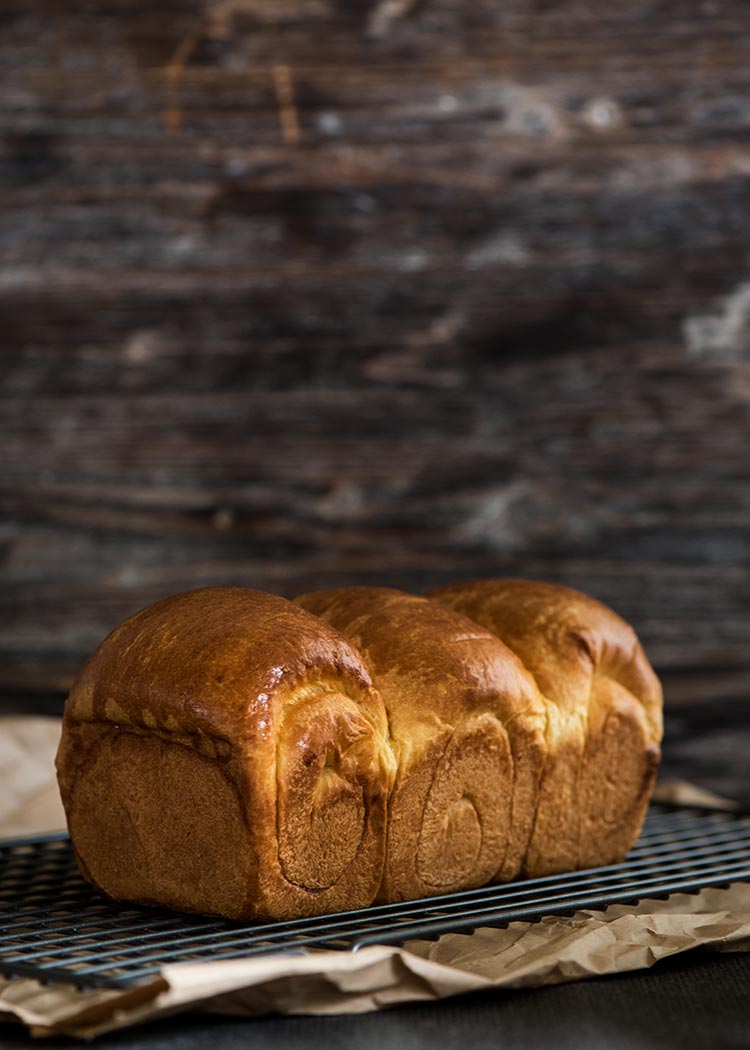
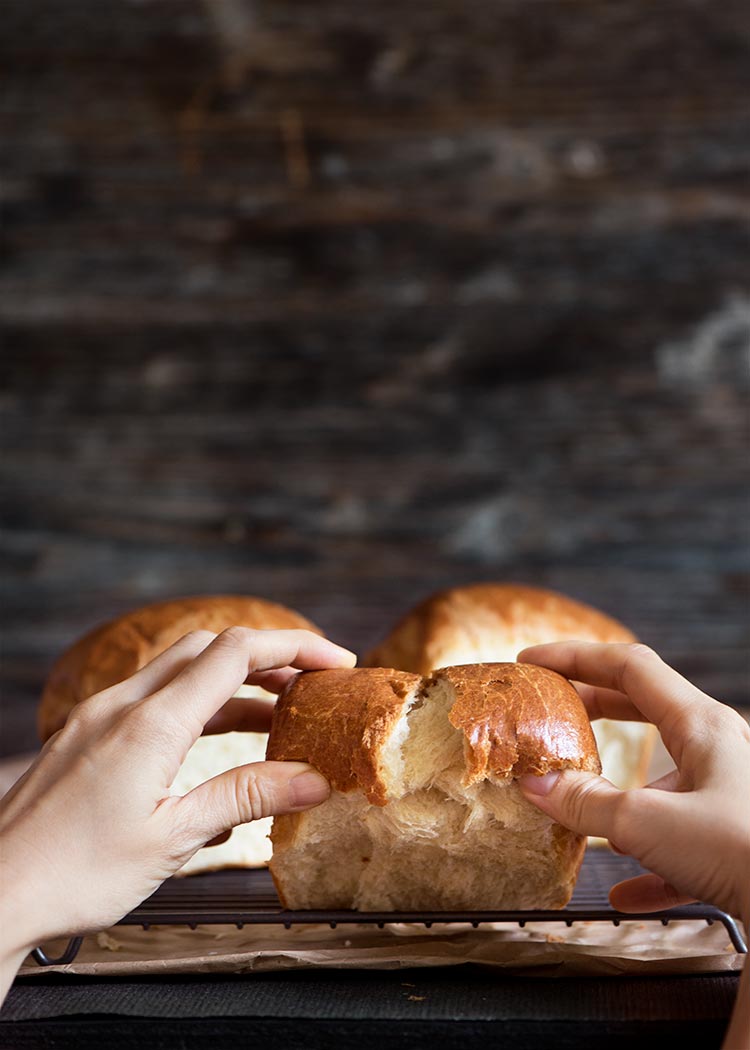
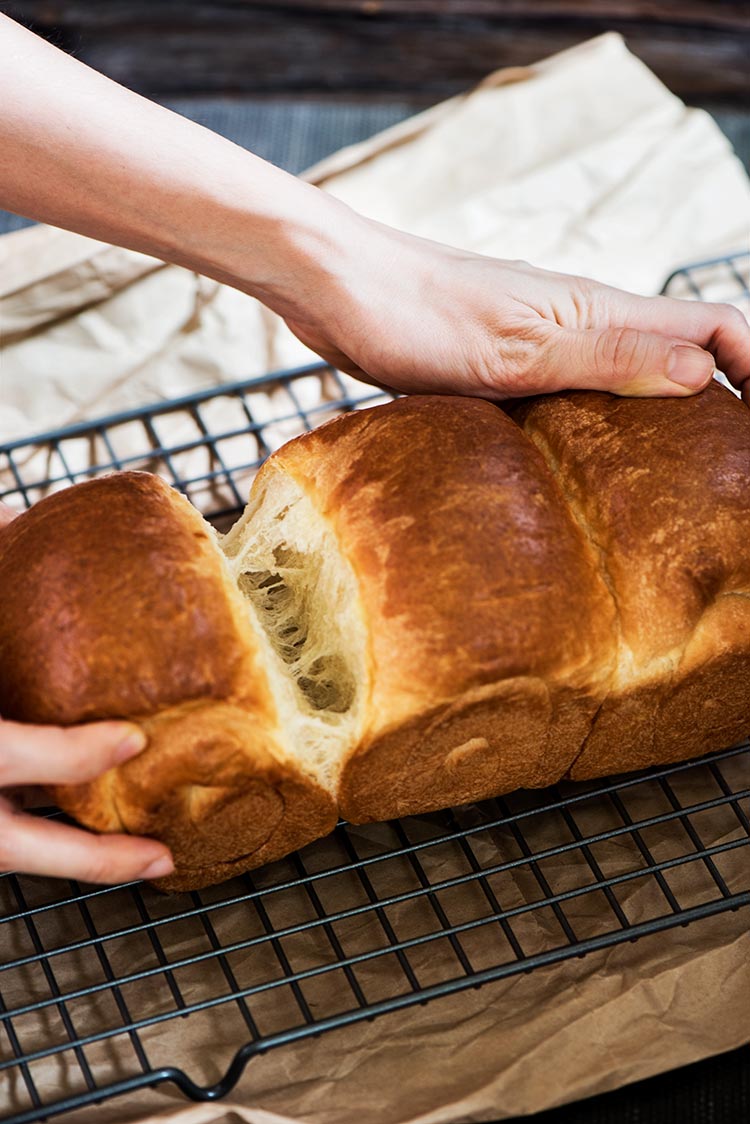
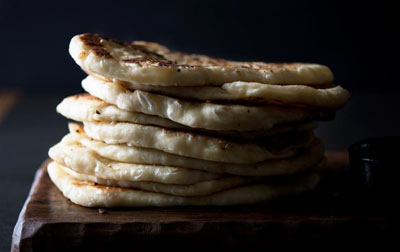
86 comments
Just made this with all purpose flour- it was SO GOOD and came out perfectly- looked exactly like the picture. I changed nothing else with the recipe- my second proof only needed to be about 40 minutes though. It even browned exactly when the recipe said it would- at about 25 minutes I needed to tent it. Perfect, flaky, fluffy bread. Amazing- I’m keeping this recipe!
Hi Ai Ping, Thank you for your recipe and teaching me about using Tangzoung. I think your recipe is very flexible because I made several changes and it still turned out very light and fluffy and delicious. I did not have milk so I used sweetened condensed milk diluted 1:1 by weight with water and omitted the sugar. Also I substituted butter with soybean oil. I started with my favorite recipe for white bread and made the recommended changes as follows: Tangzhoung: 25 g bread flour with 125 g water and whisked over low heat until 65°C. While it cooled I mixed the dry ingredients: 295 g bread flour, 5.5 g salt, 5 g yeast and set aside. To the cooling Tangzhoung, I added 40 g cool water and 40 g sweetened condensed milk, then beat in the egg. I added these wet ingredients to the dry ingredients, mixed and then kneaded about 5 minutes by hand. Then added 20 g soybean oil and kneaded about 7 minutes more, or until I was too tired. 🙂 I formed a ball, let it rise covered for about an hour, deflated the dough, then divided it into 4 pieces which I rolled, flattened and rolled up as in your video and then placed in my cast iron loaf pan lined with baking paper. After about an hour, the dough was well risen and I brushed with egg wash then baked for 35 minutes at 180°C (fan oven) but covered with foil the last 15 minutes to prevent over browning. It rose beautifully and was so soft and fluffy. It was not as sweet as I intended (and so I will add 10-20 g sugar next time) but it was very delicious anyway. For serving I enjoyed two ways: 1.spread with a thin, sticky coat of sweetened condensed milk then sprinkled with meat floss, like at Bread Talk. 2. spread with chocolate sauce by melting equal amount of dark chocolate and butter on low in microwave. Both ways were very delicious. Next time I will try making individual rolls. Half to eat savory with the meat floss. Half filled with a knob of dark chocolate and a bit of butter. (In Indonesia these are called Roti Sorbek Isi Cocklat.) Thank you again !!
That sounds fabulous. I too enjoy recipes that are flexible.
Thank you so much! I have just finished baking a loaf and it is so amazing!!! Cant wait for my family to try.
In case anyone else was struggling with the measurements in ounces, here are the measurements that I used.
For the tangzhong – 6.5tbsp full fat milk and 19g bread flour.
For the dough – 10.5tbsp milk and 343g bread flour.
I found the dough a bit sticky and difficult to shape, but the final result is fantastic, so I am not complaining. My bread looked done in 27 minutes and I removed it. Turned out fine.
Thank you for the conversion!
U r awesome too like Ai ping, thank you so much
I want to try this recipe however i don’t know how to convert the bread flour & Milk in cups..
Generally 4.25 oz is a cup. But note that if you use cups, things will go off because there will be a difference in the amount. Getting a scale is quite a good investment. 🙂
Hi! I only have all purpose flour right now. Is it okay to substitute that first in replacement for bread flour?
Sure but the bread will not be as soft unless you use a breadmaker machine.
Hi,
Im in the midst of trying the recipe as I always loved Hokkaido milk bread.
I noticed my dough hasn’t risen after 1 or more hours. I’m using instant yeast, is that the same as active yeast?
Any insights will be great as I followed the recipe as is.
Thankd
Katherine
There are several reasons why the dough did not rise. The most likely reason is that the yeast is dead. If it rose a little bit, then the dough may not have be sufficiently kneaded or the room wasn’t warm enough. Instant yeast can replace active dry yeast. Just use a little less. Hope this helps.
Hey!! Thanks for the recipe!
I just tried your recipe today.
I doubled your recipe and hand kneaded the whole thing since I don’t have a stand mixer.
I had 2 problems, first, kneading took forever. I tried the window pane test but failed every time. I got sick of it and just made the dough into a ball and did the first fermentation and it rose! maybe I over kneaded… Do you have any insight? for hand kneading?
second problem was my bread was too yeasty. maybe the yeast went bad but it did do its job but the yeast smell was very strong when I was kneading and after I baked the bread.
Bread came out nicely but it was bit too chewy, not as soft as I wanted to be. the crust was bit on a crispy side.
I assume it was over kneaded… what do you think?
I will give it one more shot next time but in half of the portion you have given 🙂
Thanks
Hey there. Doubling the recipe and hand kneading it. That takes guts. 🙂 Even I don’t have the strength to do it.
Instead of the window pane test, try the pressing it gently and if it springs back immediately, it’s ready to go. If not, there’s still much kneading to do. Also, there’s only a slight/almost no possibility you can over knead a dough by hand. 🙂 I figure it’s not kneaded enough.
What type of yeast did you use? Instant or active? I’m not sure why the yeast smell was so strong. Perhaps it has over risen. Everyone’s kitchen and temperature is different so it’s hard to say. I hope the next time will work for you. Fingers crossed.
Hi Ai Ping, this recipe looks sooooooOOOOOOooooo yummy (^___^)
I don’t have a machine to mix the dough (barely a newbie in the culinary (marvelous) world, so I don’t want to rush and buy all the cooking gears I see (aaaannnd my bank account wouldn’t allow that)).
Anyways, do you think it can be done manually, and if so, how would you recommend me to do it ?
Thanks in advance for your help, can’t wait to try it and let you guys know how it went ^^
Hi Sylvie, yes this can be hand kneaded but will be very energy consuming. The dough is very sticky so you’ll need to lightly flour the dough as you keep kneading. Overflouring will make the bread tough. Kneading by hand will take longer (just make sure dough springs back upon pressing.
Looks delicious! I’m vegan, though. Do you think it would work to use coconut milk, since it has a high fat content? Or is there another plant-based milk you think would work?
Hi Catherine. I wish I could help but I have no idea whether coconut milk or other alternative milk would work. So sorry. However, I found this on the internet and perhaps you’d like to try it. I’ve yet tried it before and can’t guarantee if it’ll work. http://eatmunchlove.com/2014/02/10/hokkaido-milk-bread-shokupan-tangzhong-method-vegan-friendly/
This bread looks wonderful, AiPing! And I really loved the video!
Hi Ai Ping, can I use breadmaker for this resipe? Thanks for sharing this resipe.
Hi Jamie. I haven’t done so before but I’ve read that other bloggers have done it. However, some would add extra kneading time while others use the bread machine only for kneading and don’t actually bake the bread in the bread machine. Instead, they’d use the oven. Since I’ve never tried it before, I can’t say anything for a certainty and you’d have to do it over trial and error. Good luck!
i am lazy enough so i am doing it in my bread making machine!
Hahaha. Nice! I’ve never made one on a bread machine so I’m very curious to find out how it goes. Please let me know how it turns out.
Hello. very good recipe. I don’t put egg and replaced butter on sunflower. try. very tasty result.
I’m glad you enjoyed it Irina.
That’s great Irina. Thanks for sharing the changes you made. I’m glad you love it.
Hi ai ping, I’m interested to try this recipe. Do you have the ingredients measurement in grams?
Thanks in advance
Hi Weliana. I’m glad that you’re interested in trying this out. I’m sorry but I don’t have them in grams. However you can easily convert them. 1 oz is 28.35 grams. Hope this helps. 🙂
I just baked this (after printing out the recipe and just sitting on it for weeks) and it turned out fantastic. I used half milk and half cream. I heard that the tangzhong method allows the bread to stay soft and fluffy longer. I’m not sure if I can test it out though because I don’t think my loaf is going to last more than two days before I eat it all!
I want to try using this method on other things like cinnamon rolls and baked yeast donuts.
Hi Steven. I’m so glad that printed recipe ended up being used instead of its unknown fate of long term ‘sittingness’. 🙂
Half milk, half cream sounds fantastic. A balance of richness in the bread. Yum! I usually bake two loaves each time as they don’t last in my home too. 🙂 And yes, they do stay soft. Let me know how it goes trying it out on other baked goods. So exciting!
Hi, I just found this recipe and will be trying it this weekend. I make all of my own bread (Thank goodness for a kitchen aid stand mixer to do the kneading) and I just wanted to thank you for sharing. I’m really excited to try a new bread and pillowy soft sounds so yummy to me.
Hi Kris. When I started making homemade bread, I didn’t own a stand mixer. Now that I do, I’m not sure if I’d like to go back to hand kneading. Haha. I can’t for you to try this recipe. Let me know how it goes.
Hello!
Just wondering if using heavy cream is a must in this recipe. I only have 2% milk on hand. Would you think the substitution would be alright? … could possibly add a bit more butter for the fat content??
Thx!
Hi Marita.
I’ve never made using 2% milk but I don’t see why it wouldn’t work. 🙂
1. When making the ‘tangzhong’, using 2% milk will take a longer time for the pudding like consistency to form since it contains more liquid vs fat. Heavy cream takes 1-2 minutes. Whole milk 2-3 minutes. 2% milk may take up to 5 minutes. Just don’t step away because once it starts to thicken, it thickens very quickly.
2. You can add another 1 tbs butter to add to the richness since you’re using 2% milk.
3. Since you’re using 2% milk, more liquid has to evaporate to reach the pudding consistency when making tangzhong so the dough may be slightly drier. So when you have formed the dough, if it feels dry (the dough is meant to be soft and slightly tacky), add the milk a little at a time until the right consistency is achieved (keep in mind how much milk you’ve added so you’ll know how much is required the next time you make it).
I hope this helps. Good luck and keep me updated with the results.
Thanks so much for the quick reply!
Well the bread isn’t done yet, on its second proof now. But I can tell it it will be awesome (I always make my bread I don’t remember the last time I bought bread! … I must say that I can fully relate to your bread machine story!)
All I changed was I used 2% milk and with what you said about the tangzhong I ended up using 0.25oz more of milk to compensate for the evaporation. All seams to have worked out well. I have never made a dough like this one before it’s quite nice!!!
Also off topic … the dough reminded me of those Chinese coconut cocktail buns when I tried the dougg (Sorry I don’t know the proper name) … is it similar? … or even better do you have a recipe for those buns? I have looked at a few and I can’t seam to settle on one.
So how was the bread? Can’t wait for you to tell me. About the Chinese coconut cocktail buns, no unfortunately I don’t have a recipe and have not tried others to confidently share it with you. Sorry about that. But you can always try this recipe with the coconut if you like the texture. I make rolls and burger buns out of this milk bread recipe too. Too good! 🙂
I use this bread for everything. Including making pizza and all other fillings.
Its soft and easy to eat. I like that.
Hey Tom. What a great idea! I’ve not thought to use this for pizza crust. I’m going to have to try this. 🙂
I plan to make dinner rolls with recipe. Do you think brushing each piece with melted butter before fold and roll will be harmful?
Hi Mamie. Is there a reason why you’d like to do so? If you would like more butter flavor, you could always add a lil more butter when kneading.
I’ve never done so before so I can’t say for sure if it will affect the rise. I shouldn’t think so but there’s only one way to find out. Test one piece. ? Good luck!
Made this bread earlier this week, so amazingly soft and delicious. I used cream and I couldn’t be happier with the results. Thanks for such a straightforward and easy recipe, I loved it and will definitely be making it often.
Hi Athena!!! So glad you dropped by and took the time to drop me a comment. I’m so happy that you tried it. It is indeed so soft & delicious. It was love at first bite for me 🙂
Hi Ai Ping
I really want to try this recipe – it looks so good! 3.25 oz. is how many ml or cups?
Hi Luz, I’m so happy you’re going to give it a try. 3.25 oz is 96.1 ml or 0.4 cups. I use a scale to weigh the ingredients. It’s easier and more accurate that way. Hope this helps!
This looks amazing and I absolutely cannot wait to try it!!
Just one question though, I store my whipping cream in my fridge. To be able to have warm whipping cream for the yeast portion upto what temperature do I need to cook it to?
Hi Cara. I’m glad you’re going to try this recipe. As for any liquid to be heated for activating yeast, I usually heat it to about 118 F. Then I’ll dissolve 1-2 tbs sugar into the liquid. This will bring down the temperature to between 110 F to 115 F. I then stir in the yeast. If I’m not using as much sugar, then I’d heat the liquid up to about 116 F. Hope this helps.
They look so soft, i will be keeping this recipe, i am just terrible at making soft rolls. thanks a bunch for sharing the recipe 🙂
If I substract the ingredients in your tangzhong ( 3.25 oz milk, 2.4 Tbsp flour ) from a recipe with same amount of flour, make a tangzhong, will it make my hot cross buns lighter? If yes should I use milk or whipping cream? Since these buns are on heavy side, milk or cream? Last, will this method work in any yeast bread recipe IE using tangzhong?
Hi Mamie. As long as you apply the tangzhong method to any recipe; regardless if your recipe calls for 12.75oz or 17oz flour, you put aside 5% of total weight of flour (along with the required amount of liquid) to make the tangzhong, it will work. Any yeast bread recipes will become softer and fluffier. I can’t say for certain for gluten free flour. As for whole wheat flour, the amount of liquid will be to be increased. All purpose flour will not yield as great result as bread flour. With regards to milk vs cream, it’s just the matter of taste. Whipping cream will yield a richer taste, slightly heavier compared to milk. You can even combine both to see what you like best. Hope this helps. Let me know if you have other questions.
Should the milk be 5% of total amount of milk in other recipes?
No. Only for flour we apply the 5%. For milk, multiply the weight of flour by 5. So let say for your bread recipe, total weight of flour is 12oz and total weight of milk is 8oz. For the tangzhong, you’ll need 5% flour which is 0.6oz (5% of 12oz) and milk will be 3oz (0.6oz X 5). So combine 0.6oz flour with 3oz milk in the pan to make the tangzhong. What’s left is 11.4oz flour (12oz – 0.6oz) and 5oz milk (8oz – 3oz).
Got it. Thank you sooo much. After I make this I will let you know how pleased I am.
Do you think I will get the same results using whole milk instead of heavy cream?
Hi there. Texture wise, yes. Flavor wise, heavy cream is richer compared to milk. When I’m out of cream or don’t feel like having the bread so rich, I use milk all the time. 🙂
This is the best recipe, thank you!! My kids loved it!
Thanks Linda. I’m so glad your kids loved it!
The current Cooks Illustrated has a recipe for dinner rolls that uses a tangzhong.
Spelt, btw, has slightly _more_ gluten than wheat. I suspect your problem was using whole grain flour, which requires extra hydration and extra kneading, and even then tends not to rise as well as white flour (the bran cuts the strands of gluten).
That’s why I find it funny that spelt was my first bread to bake. 🙂
Can I make this bread in the bread machine? If so, would I follow the bread machines instructions with liquid ingredients first and then dry?
Hi Kristine. This recipe is adapted from another recipe (http://en.christinesrecipes.com/2010/10/hokkaido-milk-toast-japanese-style.html) where the dough is kneaded using a bread machine but baked in the oven. If you want it baked in the machine, I can’t guarantee the results as I’ve never made this using a bread machine. But I’ve been told that milk bread made in a bread machine will not yield as great a result as one baked in the oven (I can’t say for sure because I’ve never done a side by side comparison).
For the ones that I’ve read who do bake in their bread maker, they’d use the sweet bread and light setting. And yes, wet ingredients first, then dry. Knead halfway, add the butter and let it continue to knead. After the first rise, remove the dough from machine onto a lightly floured work area and shape it like how I did. Remove the paddle attachments from the machine, place the shaped dough back into the machine and then let the machine finish the job. 🙂
One caveat with using the bread machine is insufficient kneading. To fix this problem, I’ve been told that some would use the jam cycle first before the bread cycle. Not sure about this though. Hope this helps.
Can the dough be frozen? There are only 2 of us so 3 loaves of bread is about 2 1/2 loaves to many. I don’t like to freeze the baked bread because to me it changes the flavor. Thanks.
Hi Tony, this recipe only makes one 8″ X 4″ bread pan loaf. It’s the perfect size for my husband and I to finish within three days. If you still would like to freeze the dough, then go ahead and have it rise the first time, shape it like how you’d bake it and then freeze it. When ready to bake the dough, thaw in the fridge overnight. Take out the dough the next day and place it in a bread pan. Let it rise the second time, brush with egg wash and bake. Hope this helps.
I didn’t read the quantity it made just looked at the 3 loaves in the picture. I will read next time. Thank you.
No worries. 🙂
How much is 0.65oz flour using a meas. cup or meas.spoon? How do you think this recipe would be made into rolls? I don’t have use for loaves. Do you have other recipe for rolls or a sweet pastry like item?
Hi Mamie. 0.65 oz is about 2.4 tablespoons of flour. This recipe can be made into rolls too for sure. It’ll be quite rich with heavy cream so perhaps you want to use milk instead. And no, I don’t have other recipes for rolls or sweet pastry. So sorry.
I see about activating the yeast, but when do we add the activated yeast to the rest of the ingredients?
Thanks for catching that. I must have been half delirious when I was writing out the recipe. It’s in Step 3. 🙂
I am allergic to eggs. can I just leave them out or do I have to substitute with something else. like egg re placer?
Hey Sonia. If you see Tip #4, I’ve mentioned that eggs give the bread more flavor (and color). They do help with tenderizing but the tangzhong does most of the work in this recipe. Use an egg replacer or substitute the egg with 2 tbs liquid and 2 tbs oil. This is so the ratio of flour to liquid stays the same. As for the brush, use milk (before baking) or butter (after baking). You won’t get the shiny glaze that eggs lend though. Hope this helps. Good luck!
Can this recipe be doubled?
Hi Donna. Yes, it can be doubled. 🙂 This recipe uses roughly 3 cups of flour. Doubling would make it 6 cups of flour. With 6 cups, you do not necessarily need to use 4 1/2 tsp yeast. You can get by with 3 1/2 tsp yeast. It may take longer for it to rise. Hope this helps.
Hi AiPing,
Thanks for posting this recipe. The result looks so yummy and I can’t wait to give it a try. Just a quick question: you mentioned this recipe uses roughly 3 cups of flour; however, I only see 1.5 cups on it. I might have missed something here….?
Hi Willa. I can’t wait for you to try this too. 🙂 Yes, this recipe uses 3 cups of flour. 12.1 oz + 0.65 oz of flour is 12.75 oz which is roughly 3 cups flour. I’m not sure where you see it stated that it’s 1.5 cups. Hope this helps.
Hi AiPing,
You are right. It’s about 3 cups! My bad. I forgot the weight-volume conversion rate of flour. You can tell I don’t do bread often 😉
Thank you so much!
No problem Willa. 🙂
Oh my goodness! I’m so excited to find this recipe. I’ve lost track of how much money I’ve spent on milk bread from our Asian local bakery. Out of curiosity, can I use my mixer to knead the dough? My Grammy would scoff at me for asking, but I have to. 🙂 Thanks!
Haha Tamara. Ssshh… don’t tell anyone but I’m gonna get myself a mixer soon too. :p But, yes you most definitely can use a stand mixer to knead the dough. And since you’re using one, you can use the higher percentage for the TangZhong (ex 10% instead of 5%). Good luck!
I can’t imagine making bread without my mixer. Hope you get yours sooner rather than later!
I think I’m going to be saying the same thing when the mixer’s here. :p It’s coming it’s coming!!! I’m so excited.
In what moment, we add the active yeast? thank you 🙂
Hi. We add yeast in Step 3.
This bread looks amazing!! Does it taste anything like brioche? I will definitely be giving this a try soon!
Thanks Cat. You could say it’s taste a little like brioche due to its rich flavor. But the rich flavor comes from the tangzhong and not from butter or eggs (since brioche has a lot more of it). Texture wise, it’s definitely different. This bread is extremely soft and pillowy. You can apply the tangzhong method to any brioche recipe to get the best of both worlds (perhaps with some adjustments to the eggs and butter or it may become overly rich in flavor). Enjoy!
So that’s what makes it so soft! I miss Japanese bread. Thank you for the recipe!
Yup yup.. soft like pillow. Amazing.